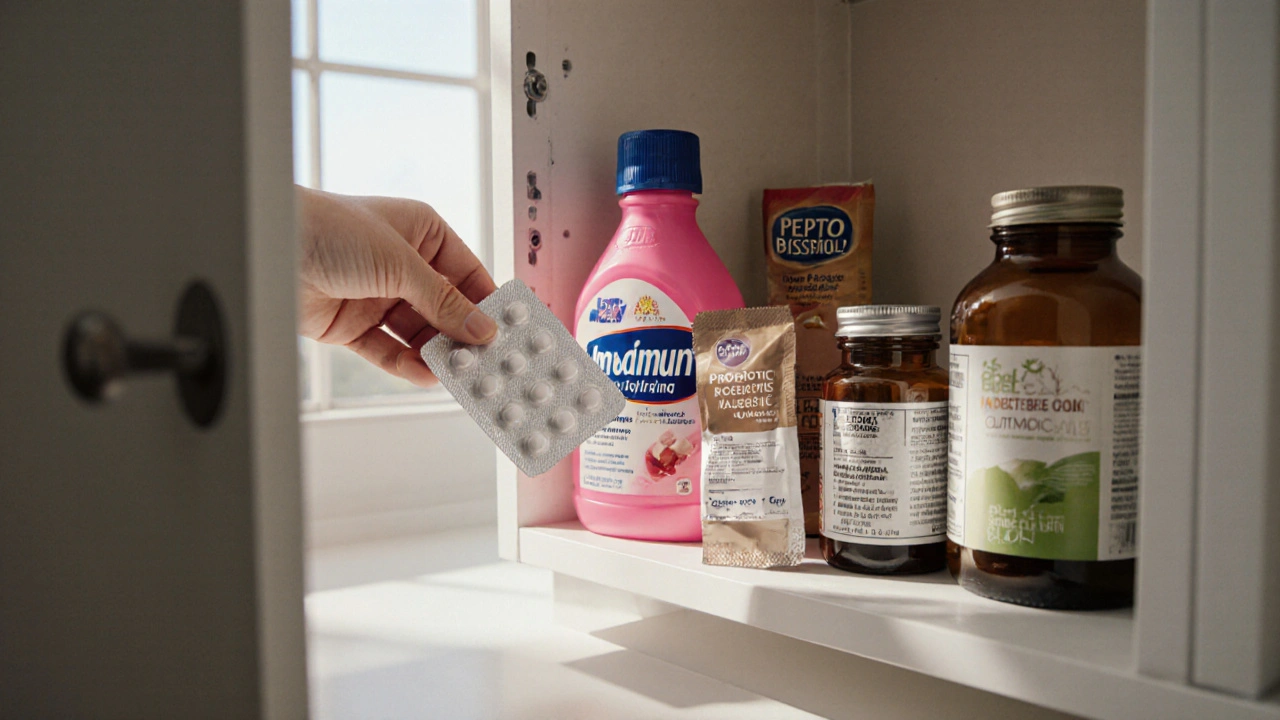Anti-Diarrheal Decision Guide
Select Your Symptoms and Circumstances
Answer these questions to receive a personalized recommendation for the best anti-diarrheal medication for your situation.
When a sudden bout of diarrhea hits, you reach for a fast‑acting drug. Imodium is often the first name that comes to mind, but it’s not the only choice. Understanding how it stacks up against other over‑the‑counter (OTC) options helps you pick the right product for your situation, avoid unnecessary side effects, and keep costs in check.
Key Takeaways
- Imodium (loperamide) slows gut movement but doesn’t treat infection.
- Alternative agents work by different mechanisms-some coat the gut, others target bacterial toxins.
- Choosing the best option depends on symptom severity, cause, age, and any existing health conditions.
- Cost and availability vary: Imodium is premium‑priced, while generic options are cheaper.
- Safety tips: avoid high‑dose loperamide, watch for dehydration, and seek medical help if symptoms persist.
How Imodium Works
Imodium is the brand name for loperamide, an opioid‑derived medication that reduces intestinal motility by binding to mu‑opioid receptors in the gut wall. By slowing the passage of stool, it gives the body more time to absorb water and electrolytes, resulting in firmer stools. The drug does not cross the blood‑brain barrier in therapeutic doses, so it lacks the central nervous system effects of stronger opioids.
Typical adult dosing starts with two 2‑mg capsules (4mg total) after the first loose stool, then 2mg after each subsequent loose stool, not exceeding 8mg per day for OTC use. Higher doses are reserved for specific medical conditions under physician supervision.

Common Alternatives and How They Differ
Below are the most widely used OTC anti‑diarrheal agents, each with a distinct mode of action.
- Bismuth subsalicylate (Pepto‑Bismol) coats the intestinal lining, reduces inflammation, and has mild antibacterial properties.
- Diphenoxylate/atropine (Lomotil) is a low‑dose opioid combined with an anticholinergic to discourage abuse; it slows gut motility similarly to loperamide but with a stronger central effect.
- Racecadotril (known as Hidrasec) is a enkephalinase inhibitor that reduces fluid secretion without affecting gut movement.
- Probiotics (e.g., Lactobacillus, Bifidobacterium strains) help restore normal gut flora, especially after antibiotic‑induced diarrhea.
- Kaolin‑pectin (often sold as Kaopectate) absorbs toxins and water, forming a protective layer.
- Oral rehydration salts (ORS) don’t stop diarrhea but replace lost fluids and electrolytes, crucial for preventing dehydration.
| Product | Mechanism | Typical Use Cases | Onset (minutes) | OTC Cost (AU$) |
|---|---|---|---|---|
| Imodium (loperamide) | Slows gut motility | Acute non‑infectious diarrhea | 30‑60 | 12‑18 (10‑caps) |
| Bismuth subsalicylate | Coats & antiseptic | Travelers' diarrhea, mild infection | 60‑120 | 9‑13 (150ml) |
| Diphenoxylate/atropine | Opioid + anticholinergic | Severe chronic diarrhea | 45‑90 | 15‑20 (10caps) |
| Racecadotril | Reduces fluid secretion | Children’s acute diarrhea | 30‑45 | 18‑22 (5ml) |
| Probiotics | Restores flora | Post‑antibiotic, IBS‑related | 120‑180 | 15‑30 (30caps) |
| Kaolin‑pectin | Absorbs toxin & water | Mild to moderate diarrhea | 60‑90 | 8‑12 (10g) |
| ORS | Rehydration solution | Any diarrhea with dehydration risk | Immediate | 2‑5 (1L pack) |
When to Choose Imodium Over Others
If you need rapid relief and the diarrhea isn’t caused by a bacterial infection (e.g., Clostridioides difficile), Imodium is a solid pick. Its quick onset and modest dosing make it convenient for adults on the go. However, it’s not advisable for:
- Children under 2years old.
- People with a high fever or bloody stools-those signs point to an infection that needs different treatment.
- Patients on certain antibiotics that can increase loperamide levels, risking cardiac effects.
In those scenarios, a non‑opioid option like bismuth subsalicylate or a probiotic regimen may be safer.
Cost, Availability, and Generic Options
Imodium’s brand price in Australian pharmacies averages AU$12‑$18 for a pack of ten 2‑mg tablets. Generic loperamide is widely sold under names like “Loperamide Hydrochloride” and typically costs half that amount. Bismuth subsalicylate and kaolin‑pectin are generally cheaper, while racecadotril and diphenoxylate/atropine sit at a higher price point due to prescription‑only status in some regions.
Online pharmacies often provide bulk discounts, but be wary of counterfeit products-check for the Australian Therapeutic Goods Administration (TGA) approval seal.

Safety Profile and Common Side Effects
All anti‑diarrheal agents have trade‑offs:
- Imodium: Constipation, abdominal cramps, rare central nervous system effects at very high doses.
- Bismuth subsalicylate: Darkened stools, mild nausea, contraindicated in aspirin‑allergic individuals.
- Diphenoxylate/atropine: Dry mouth, blurred vision, risk of dependence if misused.
- Racecadotril: Generally well‑tolerated; occasional headache.
- Probiotics: Gas or bloating during the first few days.
If diarrhea persists beyond 48hours despite OTC therapy, or if you develop severe dehydration, it’s time to see a clinician.
Decision Guide: Picking the Right Product for You
- Identify the cause. If you suspect a bacterial infection (travel, food poisoning), avoid loperamide and choose a product that addresses toxins, like bismuth subsalicylate.
- Assess severity. For mild, occasional episodes, a probiotic or ORS may suffice. For urgent relief, loperamide works fastest.
- Consider age and health conditions. Children, pregnant women, and patients with heart disease should steer clear of opioid‑based options.
- Check cost and access. Generic loperamide offers the best price‑performance ratio for most adults.
- Monitor side effects. If you notice worsening constipation or abdominal pain, switch to a non‑opioid alternative.
Following these steps helps you avoid trial‑and‑error and get back to normal life quicker.
Frequently Asked Questions
Can I use Imodium if I have a fever?
No. A fever often signals an infection. Slowing gut movement could trap pathogens and make the illness worse. Seek medical advice instead.
Is it safe to give loperamide to children?
Only children 12years and older should use it, and even then at a reduced dose. For younger kids, stick to ORS and possibly a probiotic under doctor supervision.
What’s the difference between Imodium and Lomotil?
Both contain opioid agents, but Lomotil (diphenoxylate/atropine) includes an anticholinergic to reduce abuse potential and has a slightly stronger central effect. It’s prescription‑only in Australia, while Imodium is OTC.
Should I combine a probiotic with an anti‑diarrheal?
Sometimes. If you’ve taken antibiotics and now have loose stools, a probiotic can help restore balance while a low‑dose loperamide eases symptoms. Talk to a pharmacist to avoid interactions.
How much water should I drink while using Imodium?
Even though Imodium reduces fluid loss, you still need to stay hydrated. Aim for at least 2liters of clear fluids per day, or use ORS if you’re losing a lot of electrolytes.


Lila Tyas
October 13, 2025 AT 16:10Stay hydrated and you’ll bounce back faster than you think!
Mark Szwarc
October 13, 2025 AT 21:26When choosing an OTC anti‑diarrheal, first rule out any infectious cause-fever or blood in stool means you need medical evaluation rather than loperamide.
BLAKE LUND
October 14, 2025 AT 03:00Picture this: you’re on a road trip, the stomach’s rebelling, and you reach for Imodium, only to discover a hidden bacterial hitchhiker-swap for bismuth, let it coat that rogue gut lining, and your journey continues unscathed.
Veronica Rodriguez
October 14, 2025 AT 08:33Great rundown! 👍 If you’re dealing with mild symptoms and can tolerate a little dip in stool frequency, a probiotic may gently restore flora while you keep an eye on hydration.
Holly Hayes
October 14, 2025 AT 14:06i reckon that a spot of an herbal tincture could outclass the generic loperamide, especially when one wishes to avoid that contrived chemical aftertaste-though the price point can be, well, a tad pretentious.
Matthew Shapiro
October 14, 2025 AT 19:40For adults with non‑infectious diarrhea, a standard loperamide course works well, but always respect the maximum daily dosage and avoid use if you have a known cardiac condition.
Julia Phillips
October 15, 2025 AT 01:13Imagine the gut as a bustling stage; when the curtain falls too quickly, the audience (your body) suffers. A gentle antidiarrheal can slow the act, giving the cast a chance to recover before the final bow.
Richa Punyani
October 15, 2025 AT 06:46Esteemed readers, it is with the utmost respect for your wellbeing that I recommend a cautious approach: prioritize oral rehydration solutions and, where appropriate, a modest dose of loperamide, ensuring that no underlying infection is overlooked.
Bhupendra Darji
October 15, 2025 AT 12:20Agreed, hydration first, then consider a low‑dose loperamide if the stool frequency remains disruptive; we all benefit from a balanced strategy.
Robert Keter
October 15, 2025 AT 17:53When we discuss the pharmacodynamics of loperamide, it is essential to recognize the molecular interaction with peripheral mu‑opioid receptors, which reduces intestinal motility without penetrating the central nervous system at therapeutic doses. This specificity affords a rapid onset of action, typically within 30 to 60 minutes, making it a valuable tool for acute, non‑infectious diarrheal episodes. However, clinicians must remain vigilant concerning contraindications such as febrile illnesses or dysentery, where the suppression of gut motility can exacerbate pathogen retention. In patients with a history of cardiac arrhythmias, the potential for QT prolongation at higher systemic concentrations warrants dose limitation and monitoring. Moreover, drug–drug interactions, particularly with CYP3A4 inhibitors, can elevate plasma levels and precipitate toxicity. For pediatric populations, the safety profile shifts dramatically; children under 12 years rarely receive loperamide, and those under two are contraindicated due to heightened risk of severe constipation and toxic megacolon. In these cases, oral rehydration solutions and probiotic therapy take precedence, offering symptomatic relief while supporting microbial homeostasis. The cost–benefit analysis also favors generic loperamide, which commonly presents at half the price of the branded version, thus improving accessibility without compromising efficacy. Nevertheless, the perceived premium of brand-name Imodium may influence consumer choice, highlighting the need for pharmacy counseling to guide cost‑effective decisions. For travelers confronting acute diarrheal disease, the integration of bismuth subsalicylate can address both symptom control and mild antimicrobial action, especially when the etiology remains uncertain. Finally, patient education remains paramount: individuals should be instructed to cease loperamide use if they experience abdominal distention, severe cramping, or signs of dehydration, and to seek medical attention promptly if symptoms persist beyond 48 hours. In sum, loperamide offers a potent, rapid‑acting option within a nuanced therapeutic landscape that demands careful consideration of patient age, comorbidities, and underlying disease mechanisms.
Rory Martin
October 15, 2025 AT 23:26One must consider that the pharmaceutical industry, in tandem with regulatory bodies, subtly steers public perception towards synthetic agents like loperamide, while natural remedies are marginalized, all under the guise of "evidence‑based" medicine.
Emily Collier
October 16, 2025 AT 05:00Contemplating the broader impact of our choices, selecting a safe, evidence‑based antidiarrheal aligns with both personal health and collective responsibility, fostering resilience in our communities.
Brian Mavigliano
October 16, 2025 AT 10:33Sure, Imodium works, but have you ever thought that a simple cup of ginger tea could outperform any pharmacy shelf product in calming your gut?